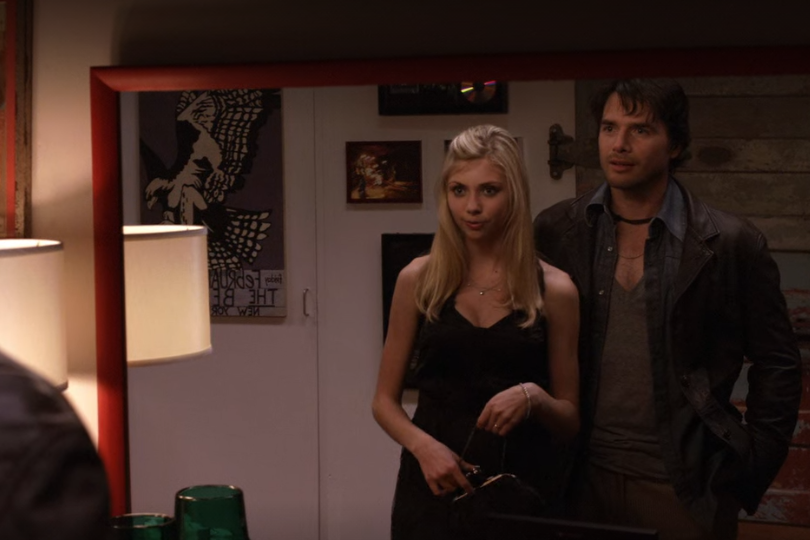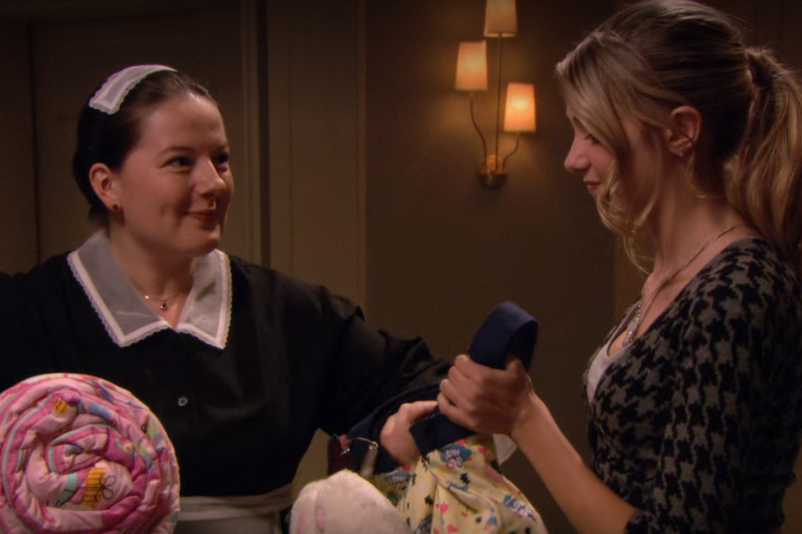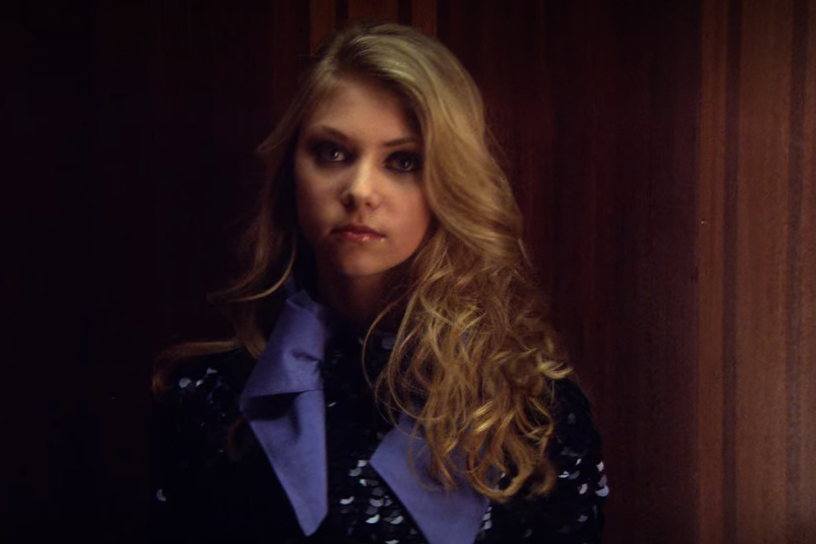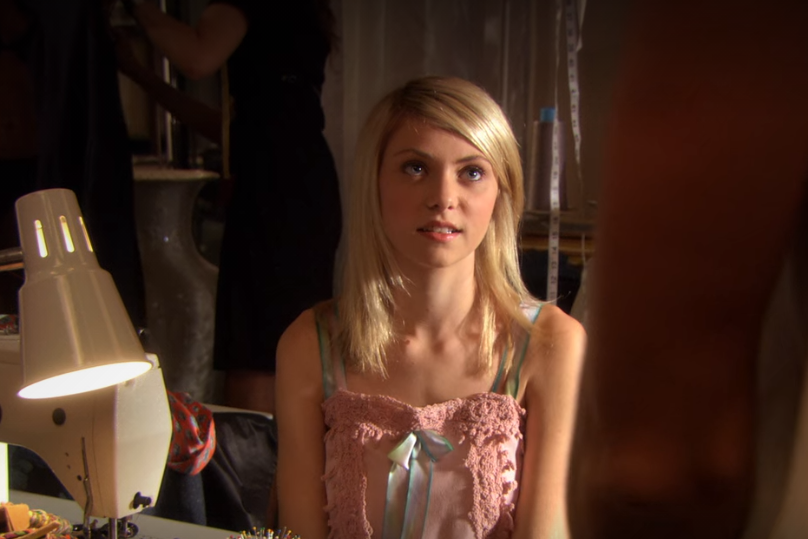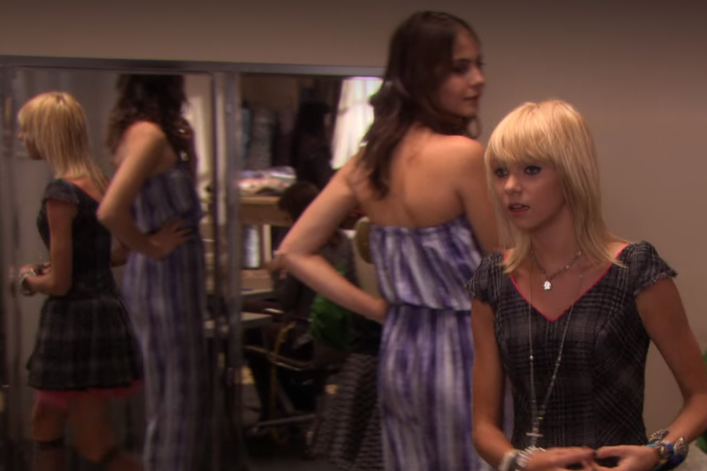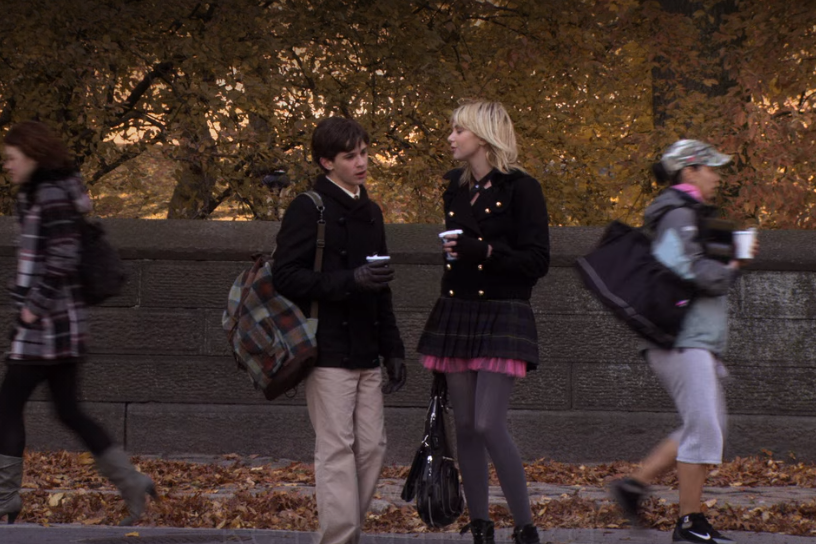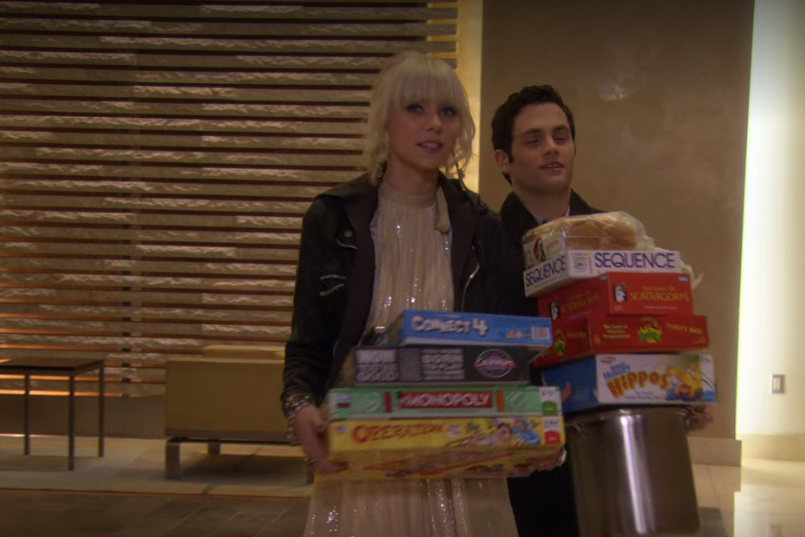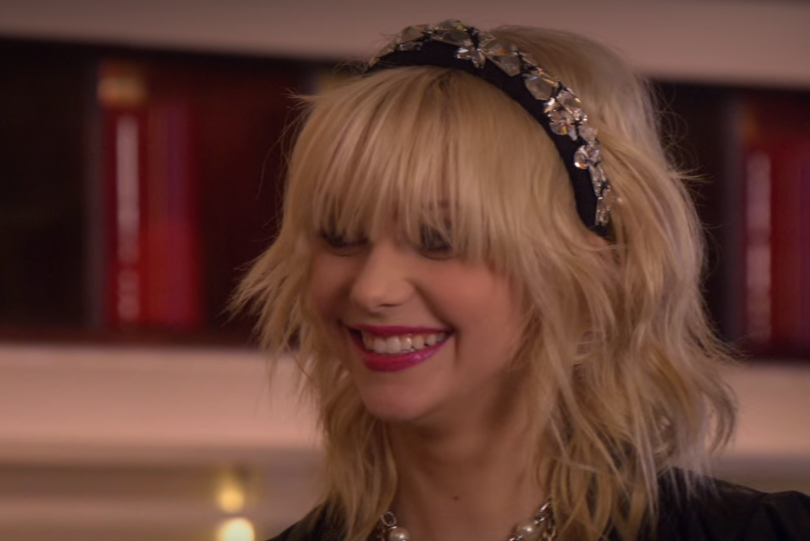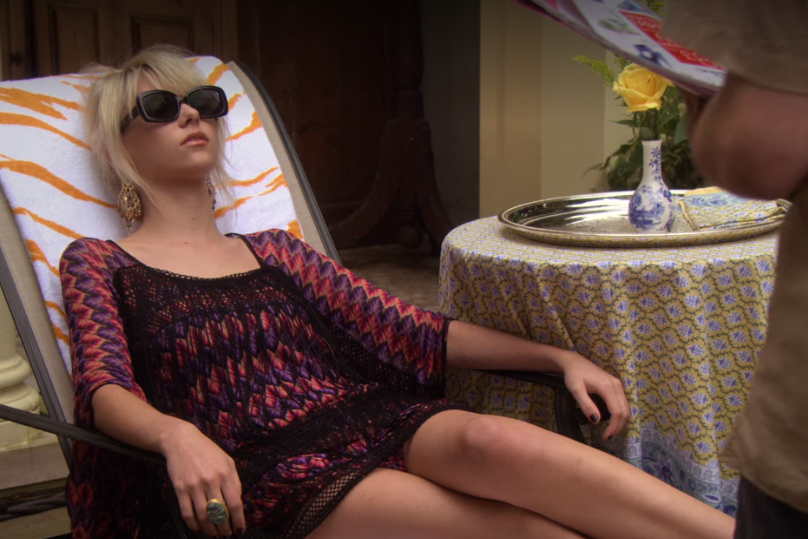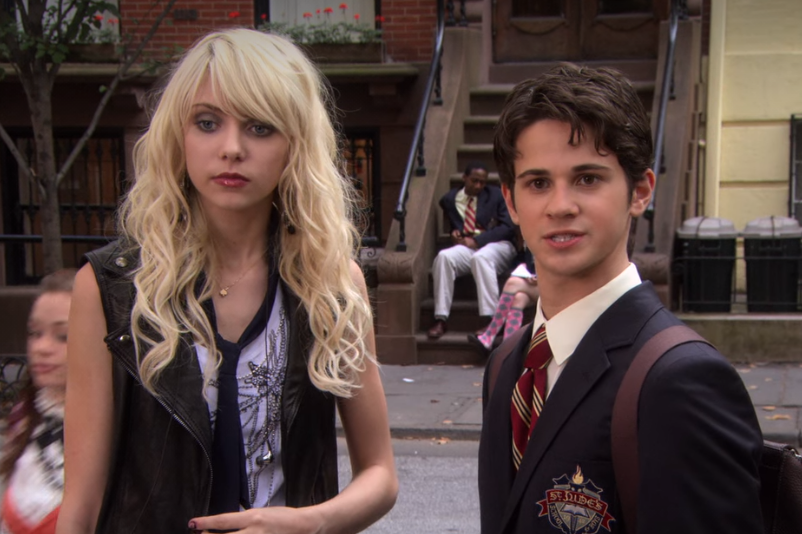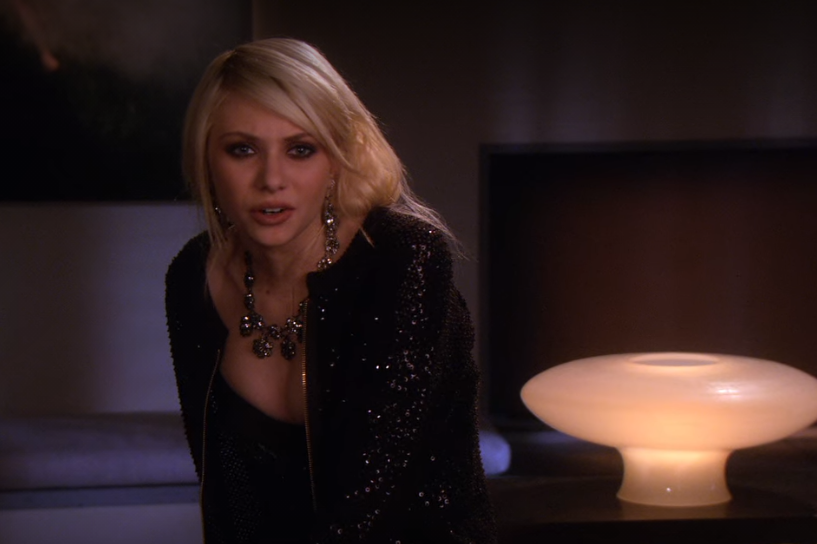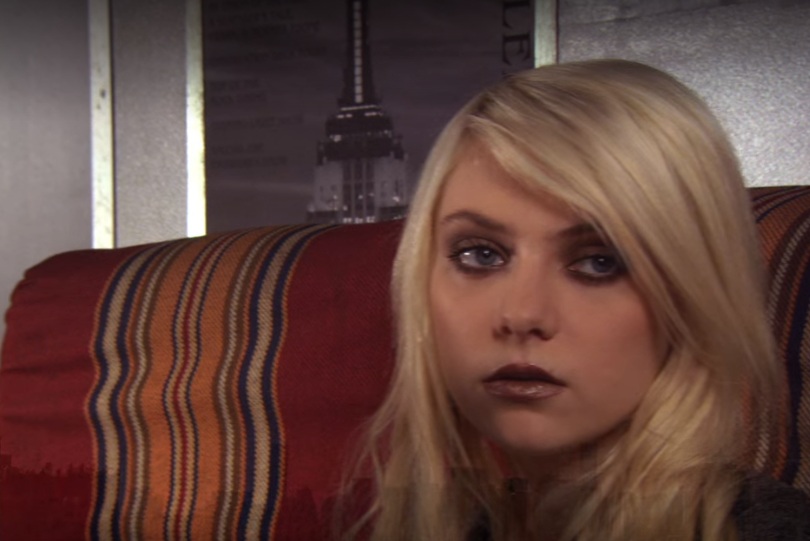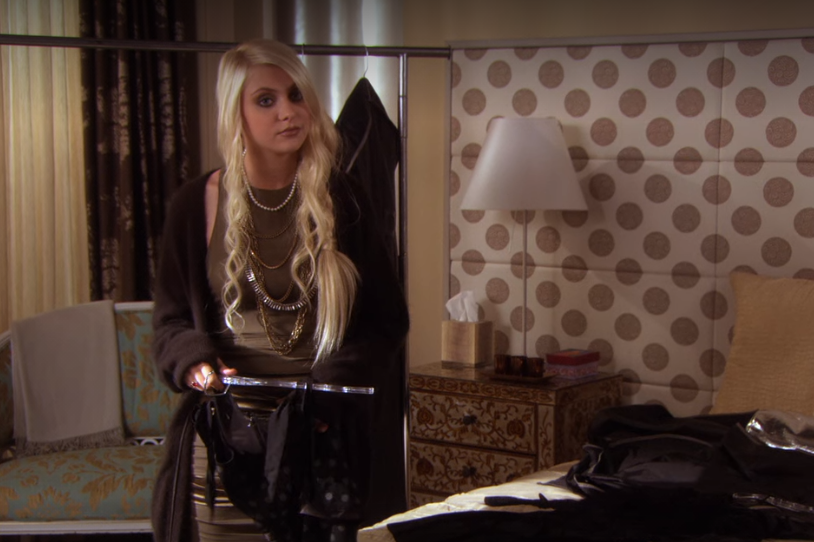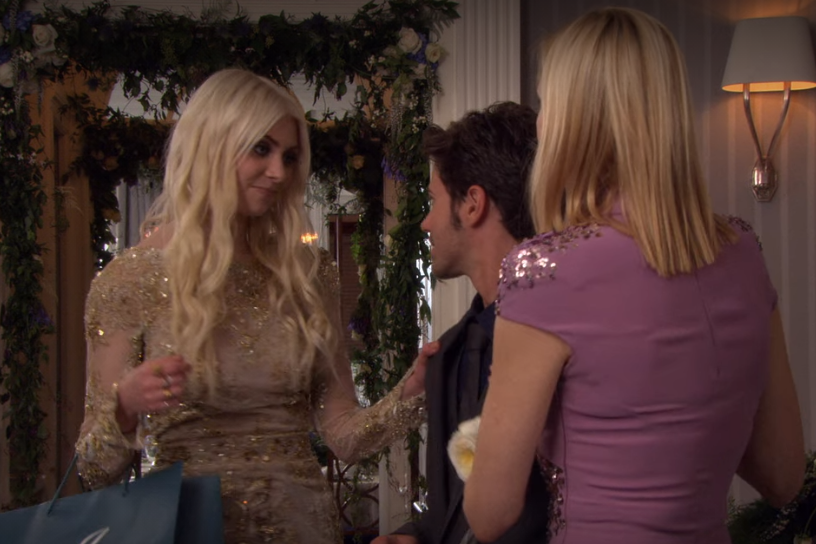The Purity of Jenny Humphrey
Originally published 12/10/2020 on Substack
[This profile contains discussion of rape culture and sexual assault.]
Of the main characters I’ll be profiling, Jenny Humphrey has the briefest arc on Gossip Girl: seasons one through three, followed by a few season four appearances and the series finale. Even in that shorter span of time, Jenny is the character whose style evolves the most, whose wardrobe is most influenced by her actor, Taylor Momsen (followed, perhaps, by Serena van der Woodsen/Blake Lively; we’ll get into her in a future issue).
By season four, Momsen’s music career (as lead singer of the rock band The Pretty Reckless) was taking off, and her appearances on Gossip Girl were dwindling. Unlike her “fellow kids” on the show, all in their early twenties by the series premiere, Taylor Momsen was a genuine teenager, only fourteen when the show launched in 2007. As her style developed from teen actress to rock-and-roll frontwoman, so did the fashion choices of her character, though for different reasons.
Eric Daman, the show’s costume designer, cites his initial inspiration for Jenny Humphrey as Molly Ringwald in Pretty in Pink. Like Molly’s Andie, Jenny is a teen girl from the “wrong side of the tracks” (“Gossip Girl Couture”), handy with a sewing machine, DIY-ing before Pinterest made it trendy. But unlike Andie, Jenny never gets her rich boyfriend, Blane (try as she might, over multiple seasons, to land the equally floppy-haired Nate Archibald). Instead, she gets the fun-house-mirror ending: having (questionably consensual) sex for the first time with Chuck Bass, aka Steff.
Like many teen soaps of its era, Gossip Girl perpetuates both rape culture (to put it simply, a culture in which rape is normalized) and the social construct of virginity—especially Jenny’s. Blair Waldorf’s and Dan Humphrey’s are written off during the first half of season one, but Jenny’s remains, a rhinestone around her neck, until the season three finale. We’ll dive even further into the show’s fashion messaging on sex with other profiles, but for now, we’ll take a look at Jenny’s evolution through the seasons and the ways her “purity,” both of conscience and body, and trauma from her sexual assaults are represented through her clothing.
[EDIT 7/2021: Throughout the original profile, I quoted from this post, “Gossip Girl, Jenny Humphrey, and Rape Culture,” when discussing Jenny’s sexual assaults. I don’t agree with the author’s aside that frames Nate as Serena’s rapist and don’t believe the show’s text or a nuanced understanding of consent supports this claim. For this reason, I no longer recommend the post and I’ve edited my profile to remove these quotes.]
I think it’s also important to note that Gossip Girl premiered ten years before the #MeToo movement became widespread, at a time when purity culture and virginity were a huge part of teen pop culture (remember all the Disney stars wearing promise rings?). I’m not saying this to excuse the show’s storytelling, but rather to highlight how mainstream its representations were, and in many cases, still are.
[In every profile, I will cite Eric Daman’s thoughts where they are relevant, though many of my conclusions will be drawn from my own observations and reading, and may not have been his intention. As with any movie, show, book, etc., authorial intent can provide insight into the work, but it is not the definitive interpretation. I believe that once a work is in the world, it becomes as much the reader’s or viewer’s as the creator’s.]
Season One
At the beginning of the show, many of the mainstays of Jenny’s style are meant to make her look even more innocent and childlike than the rest of the cast: bright or pastel colors (but with “an earth tone kind of underset” (“Couture”) to ground her to her father, Rufus, and brother, Dan) and “lots of gummy bracelets, and candy bracelets, and really cutesy necklaces” (“Couture”). Even the shape of her pieces are youthful: For her Constance Billard uniform, she favors a pinafore, not a skirt; on top, a swing cropped jacket or sweater, instead of a blazer.
Let’s take our first look at Jenny’s uniform (1.1) as an example. Note the pinafore, of course, but also the necktie (tying her—sorry—back to her brother, though his own tie is less carefully knotted) and the short-sleeved blouse, the sleeves and Peter Pan collar sweetly trimmed in blue. Freshman Jenny has agreed to address invitations for the party of the week, Kiss on the Lips, in exchange for her own invite. When she presents her work to junior Blair, the queen of Constance, and her minions, we see her gray tights and white-and-black polka flats, her pink ditsy-floral coat.
Though the overall look is less practiced and expensive than Blair’s and the minions’—their white knee socks and heels, tweed jackets and jeweled headbands—Jenny’s obviously already taking pointers from the girls she idolizes. As Daman notes, Jenny may not have as much money or status as her Constance classmates, but she is adept at pulling pieces from vintage and thrift stores that reflect current trends (“Couture”).
After school, Jenny tries on party dresses at Henri Bendel, calling in Dan for a fashion “emergency.” The dress shown, its orangey-pink shade in Jenny’s usual bright palette, costs “more than [their] rent,” but Jenny thinks she can “sew something like it.” They run into Serena and her own brother, Eric, and Serena says that the dress “would look even better in black.”
Later in the episode, Jenny has taken Serena’s advice and remade the dress in black, finishing it with a dainty rhinestone necklace and bracelet, barrette, vintage-looking clamshell bag, and ballerina-like low heels. Rufus, upon seeing her in the outfit, says, “Oh my god. My daughter’s a woman. . . . You look like your mother.”
His words, if creepy, become oddly prophetic—the dress marking her entry into the world of the more mature Upper East Side, her ties not to her mother, her family, but to other Constance girls, to the pain they share. At the party, Chuck chooses Jenny as his next victim and invites her up to the roof on the pretense of “talking.” After trying to ply her with champagne, he forcibly puts his mouth on hers and pins her arms; Dan and Serena soon interrupt his assault. Earlier in the episode, Chuck similarly assaults Serena, after revealing he saw Serena and Nate having sex—the implication being that if Serena will sleep with her best friend’s boyfriend, she’ll sleep with anyone. It’s sadly fitting, then, that Serena was the one who told Jenny the dress would look better in black—knowing, most likely, that black will be a more sophisticated choice than bright pink for an Upper East Side party; not knowing, of course, the other initiations it will come to symbolize. The color black has many meanings in U.S. culture—elegance and chicness, death and mourning. Most importantly, black is often juxtaposed with white—the color most associated with purity, innocence. (There is, of course, racist reasoning behind this dichotomy.)
Remember the color black, the black dress; they’ll come back again and again—not just with Jenny, but with Blair, too. After all, it is Blair who Jenny asks if Chuck is bragging about her, Blair who tells her, “If you want to be part of this world, Jenny, people will talk. Eventually. And you need to decide if all this is worth it.”
Let’s jump ahead to episode five. Jenny’s uniform has updated slightly: still a pinafore; a Peter Pan collar; a plaid swing jacket with big buttons, in a Humphrey-favored neutral plaid (appropriate, as she’s advising Serena on her date with Dan); but instead of a necktie, the crossover tie that Blair favors. It’s a small change, but one that’s believable for Jenny at this point in the season. I can imagine Rufus being willing to spend money on new uniform components; all for her education!
Blair invites Jenny to her annual sleepover (a substitute for Serena, who’s busy with her date). Jenny arrives prepared for any normal sleepover: her Hello Kitty sleeping bag and floral tote, a pair of bunny slippers tucked in the front pocket. She’s not expecting the trundle beds, racks of clothes, Blair in a silky slip and robe. Jenny wears a gray tank and cropped houndstooth cardigan, a key among the many charms on her neck. It’s a marker of her lower-class status: Blair doesn’t need a key to her home; an elevator opens into the foyer.
Blair runs Jenny through a series of outfits, until they settle on a yellow strapless dress, a black-and-gold coat added outside—an appropriate choice for Serena’s stand-in, as yellow and gold are usually her colors. “I don’t really feel right,” Jenny tells Blair, and the little gold question mark around her neck confirms her emotional state; she’s uncomfortable in this new world of sex and drinking. As the night wears on and more gin martinis are downed, and Jenny engages in a series of escalating dares with Blair, she gains more confidence, ending the episode by successfully stealing a sequined jacket from Eleanor Waldorf Designs, Blair’s mother’s store.
Again, this isn’t a normal Jenny piece: the sequins more Serena, the bold blues more Blair, but its high neck covers any initial question of what she was willing to do to enter this world. She’s in, and she believes that it’s “worth it.”
In episode six, we see the same yellow color story for Jenny, but this time she is harnessing her newfound power, attending a masquerade ball in secret. Her mask is still very Jenny—silver jeweled with a spray of pastel purple feathers—but her yellow confection of a ball gown and printed fan (all supposedly borrowed from the costume department at BAM) are enough to disguise her to Chuck. She plays hide-and-seek with him, but this time, he’s left locked on a rooftop, without his clothes, phone, or dignity. Jenny is delighted by the outcome—“[the night] was everything I hoped”—and the viewer is left to think that she’s now “over” her assault.
In the party’s bathroom, she trades accessories with Serena, who is also wearing a yellow dress. In her new mask and fur stole, Jenny is quickly mistaken for Serena by Nate. Though he’s supposed to be finding Blair before midnight, Nate instead confesses his feelings for Serena, telling Jenny he’s going to kiss her if she doesn’t stop him; when he does a few seconds later, Jenny runs away. Now, Nate is never the most perceptive character in a room, but even Blair, even Jenny’s own brother, Dan, confuse the fleeing Jenny with Serena. With the luxuries of wealth—the filigree of the mask, the fur of the stole—come the weight of more secrets, more trauma. The colors, too—black and gold—echo the previous two times Jenny has imitated Serena. Jenny leaves behind only a rhinestone bracelet, but it’s enough for Blair to realize that she’d snuck into the party.
At Blair’s insistence, Jenny reveals Nate’s confession (1.7) and is dismissed as a minion “for good” by her humiliated queen. While their outfits may initially seem complementary—sharing the same palette, the same pattern, they’re actually dissonant. Blair wears a preppy cream cardigan, green plaid shirt, and blue skirt with small white polka dots; Jenny’s swing jacket, paired with a plain purple shirt and jeans, is the inverse of Blair’s skirt: large lavender dots on a cream background. The effect is much sweeter, more childish, and ultimately, less powerful. Even Jenny’s question mark necklace makes another appearance, signaling the confusion that Nate’s secret has reintroduced into Jenny’s life.
Still, Jenny’s job assisting at the upcoming cotillion only reinvigorates her interest in the Upper East Side, and after she helps repair Blair’s cotillion dress, she’s back as a minion, if a continually hazed one. But the answer to her woes soon comes: she overhears Serena telling Dan that Blair has slept with both Nate and Chuck, and once Gossip Girl spreads the rumor, Jenny confirms it to Nate (1.13).
The other minions soon dethrone Blair, and Jenny follows them up the Met steps, leaving Blair behind. No headband, like the older girls, only a pink studded beret. Her blue coat, a repeat from earlier in the episode, has a juvenile hood and toggles; perhaps she got it last year and pulled it out again this winter. But, under her crossover tie, a ruffled blouse collar, much like the high-necked collars Blair favors, peeks out; a glimmer of power.
This outfit serves to make Jenny’s next appearance even starker. She checks off three items that she’s never worn before: a pointed collar, a gold headband, and a long plaid coat, not in a safe Humphrey neutral but a bold Waldorf red. A new minion agrees to return Jenny’s library books, and like Jenny before her, she wears a pink hat. Hers is even more youthful than Jenny’s: a Fair Isle knit, two tassels framing her face. Jenny is no longer the youngest innocent, the go-to gofer, in the group.
With Blair dethroned, Jenny falls in step with the rest of the minions, though she can’t keep up with them for long: While her collars are ruffled and her head is banded, she doesn’t have the money for an endless parade of looks. In episode fourteen, she repeats her mint coat a few times, the collar’s flower appliques a more luxurious, tactile version of the ditsy floral prints she once favored. Ironically, the coat itself is Valentino—the same brand as the red gown Jenny later steals from a minion’s mother’s closet. She trades the stolen gown for a vintage black-and-gold Dolce & Gabbana, telling the shop owner that the dress is “more [her] color.” Strange, as the only times she’s worn black and gold in the series are when she’s imitated Serena.
After the minions discover her thievery, Jenny is able to keep her position in the group by first bringing Nate as a date for one of the minions, and then by finding her own rich boyfriend, Asher.
Bubble Episode
This brings us to this profile’s bubble episode: an examination of each outfit worn by the character in one particular episode. For Jenny, I chose episode sixteen, “All About My Brother.” Selfishly, perhaps, because it features some of my favorite Jenny ensembles, but also because it’s one of three (three!) episodes that center on Jenny’s virginity.
In the first scene, Jenny, Blair, and their respective minions meet for breakfast on the Met steps. It’s easy to tell each minion’s allegiance: Jenny’s girls are pastel, while Blair’s are bold. Jenny is working her new staples—a pointed collar, a headband—while her buttery trench evokes her earlier forays into yellow. Jenny is hosting her first Upper East Side party with Asher that evening, and she’s high on the power of having a wealthy, handsome boyfriend.
And yet, her fishnets stockings, paired with silver Mary Janes, are an unexpected touch. While Jenny will don many pairs of fishnets in seasons two and three, she’s never worn them before in season one. Fishnets are often associated with female sexuality and availability, so their appearance hints at the story to come.
The same morning, Dan sees Asher kissing another boy outside school and confronts him. “Are you calling me queer?” Asher replies and then utters two sentences that have haunted my nightmares for twelve years: “You wanna know how queer I am? I’m so queer I’m gonna pop your sister’s cherry tonight.” Instead of gagging, Dan continues the grand tradition of men protecting Jenny’s “honor”; his attempt at a beatdown is quickly stopped and dismissed by Jenny. To try to get Jenny’s attention, Dan sends the story to Gossip Girl.
Later, Jenny asks Asher about the blast, looking infinitely younger: her yellow power trench, in various states of undone since breakfast, is gone, revealing her pinafore underneath. Even her blouse looks more childish: now we can see it’s pale pink and white pinstriped, with little bows on the short sleeves. She tries to initiate sex with Asher, but he rebuffs her, explaining what he thought was implied: Jenny is his beard, his social status and resources in exchange for her cover. He asks her if they can “put the rumors to rest,” and a few hours later, a Gossip Girl post claims that Jenny lost her virginity to Asher.
Dan, keeping in character, yells at Jenny about the blast, and she confirms it isn’t true. In the privacy of their loft, she wears a striped cardigan, a little fabric boutonniere at the bust. Like the fishnets, the flowers reflect the story—a physical manifestation of her supposed “deflowering.” Much like the little appliques on her mint coat, these flowers are tangible, touchable: the stuff of real consequence. Jenny leaves for the party against her father’s will: “I’m not a little girl anymore. You can’t make me do anything.”
The flower motif continues through the party itself: Jenny’s lilac dress is covered with little blossoms; her matching headband, too. Eric arrives and reveals, in front of all the guests, that he was the boy kissing Asher that morning; Jenny tries to cover for her boyfriend, but Blair proves Eric’s story by sending Asher’s texts to Gossip Girl. With that, the minions leave Jenny behind for their true queen, Blair—herself wearing a black dress. She carries all the sophistication and power Jenny has strived for since the pilot, and yet with it, a heaviness, the pearls pulled tight around her neck, bound around her wrists.
Much like the night of the sleepover, Jenny returns to the Waldorf penthouse, but this time to tell Blair she’s done with their games: “You asked me before if it was all worth it. My answer is it’s not.” Over her party dress, she’s thrown a hooded coat in various checks of brown, blue, and black, almost like a deconstructed Humphrey plaid. She’s going back to Brooklyn and her family, done (for this season, anyway) with the Upper East Side.
After Jenny returns home, the season is pretty much a wrap for her. The finale ends with the promise of a summer Parsons internship with Eleanor Waldorf, Blair’s mother.
Season Two
The next season opens at the end of summer: Jenny running errands for her internship in loose, easy dresses, perfect for sweaty days in the city. These dresses retain many of her season one hallmarks—pastels, bows, florals—but they are largely unimportant. I can imagine Jenny grabbing one every morning from her closet, throwing it on because it’s what she wore last summer and she doesn’t have time to buy or make new ones. What’s important is her growing responsibility at Eleanor Waldorf Designs, the praise of Eleanor herself.
A new school year begins, but the minions haven’t forgotten Jenny’s humiliation. “You can’t hide out at Eleanor Waldorf’s atelier anymore,” one of them tells her. “Your day will come. We’re just picking our moment” (2.4). In the scene, Jenny wears a blouse in the same shape as the day she lied about having sex. This one, however, is in an even paler yellow, a sad whisper of her once power, her crossover tie tucked underneath, as if she’s ashamed of the days when she pledged allegiance to Blair. It’s no wonder, then, that Jenny starts skipping school to spend more time at her internship, culminating in a fight with her father at Eleanor’s fashion show (2.5), in which one of Jenny’s designs accidentally walks, then receives the most attention.
Eventually, Rufus agrees to homeschooling, and away from the Constance girls, Jenny has more freedom to play with her style. She starts to incorporate more rock-and-roll pieces into her wardrobe—slowly, as is believable for a girl who doesn’t have infinite wealth. Episode seven is the pivot point; check out the outfit above: the ombre-striped T-shirt and gray-wash jeans. Her hair is a little more layered and razored, her eyes more heavily lined. The difference is noticeable but not jarring, cushioning the later impact of this:
In episode eight, Jenny’s hair is even “shorter, blonder,” her eyes even more raccoon-like. The dress, she made herself: gray plaid, like a good Humphrey, but layered with a rhinestone pendant and a rosary. Still, the influence of younger Jenny peeps through: the trim and petticoat are done in a favorite color, bright pink, and evoke the blue trim on an old school blouse.
At the atelier, Eleanor walks back on her promise that Jenny can sit in on a meeting with the Bloomingdale’s buyer. Afterward, she tells Jenny that the plaid dress is the only one the buyer was interested in, and Jenny agrees to remake it in one of Eleanor’s prints. Instead, she goes out with a teen model named Agnes (which I believe is Greek for “bad news”), and they trade outfits, leaving Jenny without a pattern to work with. The whole mess results in Jenny quitting Eleanor’s, buoyed by Agnes’s praise and the idea of starting her own line. In the next episode, Jenny and Agnes take over an Upper East Side gala with their guerilla fashion show. Rufus is furious, almost has Jenny arrested, and she soon moves in with Agnes.
Eric Daman cites Cherie Currie, the lead singer of the Runaways, as his inspiration for rocker Jenny (Stylecaster interview). Both were sexually assaulted as teenagers; both used fashion to shape themselves into someone who looked harder, edgier—angrier. The rocker look is associated with rebellion, sex and drugs, danger, and, of course, black. Jenny Humphrey wore black only a few times in season one, all when she was playing with power, and others were playing with her, and so I find it fitting that black is suddenly the color she’s wearing most often, to look older, more in control; almost as if she’s grasping at the stability she once had.
That being said, I don’t want to pretend Jenny’s style is completely new or entirely influenced by her sexual assault. Some elements of her look are familiar, perhaps comforting to Jenny—even when she’s rebelling against her father, she’s dressed in the same plaids, the same leather jackets, that he wears. Even when she’s angry at the Upper East Side, she wears pearls, like Blair, and big necklaces, like Lily and Serena.
Jenny’s attempt at her own line soon crashes and literally burns, thanks to Agnes setting a trash can of her dresses on fire (2.10). When Jenny finally returns to the Humphrey loft (2.11), she changes into a simple gray T-shirt and bright leggings, much like old Jenny might wear around the house, and removes her raccoon makeup—allowing herself, for a moment, a little more softness and youth. (There’s also a whole love triangle with Vanessa and Nate, but this profile is already long, so we’ll get into that in their own profiles.)
Jenny returns to Constance in episode fourteen, still wearing a pinafore and crossover tie, but this time with a black peacoat on top; a gray T-shirt, a pink tulle skirt underneath: little pieces of her new style that she’s carrying with her. Her attention soon turns from the Constance minions to her father’s impending engagement to Serena’s mother, Lily—and all the access and money it brings.
Serena takes Jenny to buy her “dream dress” for her sixteenth birthday. She and Lily think Missoni is “right,” and it is—for the van der Woodsens. (I don’t know how anyone sees colorful zigzag knitwear and thinks, Jenny Humphrey!)
Serena’s friend Poppy (which I believe is flower language for “even more bad news”) points Jenny to a glittery champagne-colored swing dress, but Jenny, who has asked for a quiet night of board games and chili, selects a simpler black dress instead. Poppy convinces Serena that Jenny’s wistful gaze at the first dress must mean she secretly wants a big blowout, and they tell Jenny to try it on.
For the party, Jenny pairs her new dress with a black motorcycle jacket and bright pink heels—a little bit Humphrey, a little bit van der Woodsen. When she arrives, she discovers that Serena has orchestrated a huge party, full of people Jenny doesn’t know or hates. (Think that Gilmore Girls episode when Emily throws Rory a truly embarrassing birthday party.) This push and pull—between her rock-and-roll Brooklyn roots and her sparkly new Upper East Side life—will become the foundation of the next season.
Of course, one of the greatest threats of this new life is the presence of Chuck. After Chuck’s father died, his stepmother, Lily, adopted him, and he has his own room at the van der Woodsen penthouse. In episode twenty-one, he interrupts Jenny’s date at the penthouse with his own, pausing their make-out as they walk to his room only to say, “If you hear screams, don’t worry. We’re fine.” You know, just a little insensitive.
Later, Jenny confronts Chuck, telling him she’d never want to live with him, that he’s lucky she never told Rufus or Lily about his assault. (He agrees, decently, to move out if she moves in.) In this scene, Jenny is dressed simply: a gray tank and jeans, a few necklaces, including the pearl one she’ll come to favor in season three. She is, for the first and only time in the series, laying bare the rage and hurt that Chuck has caused her; in this moment, she doesn’t need black clothes or heavy eyeliner to speak for her, or a masquerade gown to exact a revenge. Unfortunately for both Jenny and the viewer, we see this emotional reckoning only once.
At the end of the season, Jenny becomes queen of Constance for the coming school year, chosen by Blair herself. The queen headband, selected by the current minions, is black with large gems, as if it were meant for Jenny all along: “Starting next year,” she says, “no more headbands, except for this one.”
Season Three
By the season premiere, Jenny is vacationing with the van der Woodsens in the Hamptons, and her style has evolved into a “kind of a cross between the Brooklyn and the Upper East Side girl; it’s a little Serena van der Woodsen sprinkle, and there’s a little original Jenny Humphrey” (“Gossip Girl Style”). She has more money to play with, and so her pieces are more expensive—less vintage, more designer.
Take, for example, this pool cover-up; it’s Missoni, the very same brand that seemed so incongruous for Jenny last season. Says Daman, “I wanted to find something that combined the Upper East Side world with the colors and the idea of a Missoni piece, but the black fringe takes me back to the rock and roll world” (“Gossip Girl Style”). While Jenny once resisted the Missoni dress that Serena ultimately bought her, she’s now indulging in the luxuries of an Upper East Side life.
Still, Jenny hasn’t fully embraced the idea of being queen: She decides against wearing her headband, and instead, her first-day uniform (3.4) consists of a leather vest, white graphic tank, necktie layered with necklaces and silver earbuds, and skirt. It’s sleeker, more pared down than her previous uniforms—not a crossover tie or pinafore in sight—and the difference is obvious when we see her minions:
They seem to have scoured Jenny’s Facebook photos, dressing as a hybrid of her season one and two looks: jeweled headbands, raccoon eyes, layered necklaces, pinafores, leather jackets, and lots of gummy bracelets. Each minion wears a little number charm—much in the style of Jenny’s question mark necklace—presumably so she can tell them apart. Jenny is disturbed by their style choices and declares to the Constance girls that her regime will be a “new era”—no more hierarchy or headbands. Her minions are aghast, and by afternoon are back to dressing like Blair, even wearing headbands borrowed from her.
To reclaim her crown and dismantle Blair’s puppet regime, Jenny teams up with Chuck. “You’re fooling yourself,” he tells her, “if you don’t think you were born to rule this school.” Jenny replies that people change, but Chuck disagrees: “Not you. Not about this. Jenny Humphrey, who used to sit in Brooklyn and watch the lights across the water, who went toe to toe with Blair Waldorf and won her respect. You can’t tell me that girl isn’t still in there.” The show plays their conversation as a sweet moment, but Chuck’s lines are a little rich coming from a man who assaulted that very same girl.
And yet, his words are enough to manipulate Jenny into attending a movie premiere with him. She shows up in a strapless dress, alternating bands of camo green and black rhinestones; her jewelry including her pearl necklace and a silver cross. Chuck makes some skeevy comments, and they walk the red carpet; Blair is, of course, outraged to see her boyfriend with Jenny, and Jenny wins back her crown. This time, though, she’s decided to rule.
The show soon gives Jenny her own love interest: in episode ten, she meets Damien the Dealer™ (choosing a first name associated with the devil is one of the show’s greatest subtleties). Jenny has grown bored and lonely as queen, and Damien provides the excitement and companionship she craves. He brings her along on one of his deals, but Chuck continues the grand tradition of men protecting Jenny’s purity and interrupts, taking her home before she can try the product.
At the penthouse, Chuck gives Jenny more tender advice: “It takes one to know one. I saw that look in your eye the very first day you came on my radar. . . . If you go down the rabbit hole, it’s going to take more than Blair Waldorf and your army of minions to drag you back out.” Ignoring, of course, what he did on the very first day he saw her; ignoring, of course, the effects his actions have had on her own. Chuck is rewriting Jenny’s narrative to her face, and like any rebellious teenager, she only burrows in deeper, texting Damien as soon as she gets back to her room. Damien, it seems, is the perfect hybrid of Nate and Chuck: a floppy-haired Ken doll on the outside, and a twisted schemer on the inside; her dream meets her hell. He even dresses like her, in lots of blacks and grays, with touches of Nate blue.
Jenny continues helping with Damien’s drug runs, even earning a share of his profits. In episode twelve, she uses the money to buy black YSL Roady bags for all her minions. The it bags are the perfect tools for minion allegiance, yet they also obligate her further to Damien, tying her power as queen to his wealth. Their relationship is still only platonic, but when Jenny gets in trouble for having Damien and his stash of pills in her room, she asks for more: “I’m getting exiled to Brooklyn for our relationship and I don’t even know if we have one.”
Jenny and Damien become romantically involved, leading to—what’s that?—the second episode about Jenny’s virginity?? In episode fifteen, Jenny skips school so they can kiss in a hotel room but says she has a Latin quiz once Damien starts to reach up her kilt. On top, she wears a white Henley, necktie, and, of course, a black-and-gold cardigan—hinting at, perhaps, an impending conversation with Serena. Damien asks Jenny if she’s a virgin, and Jenny, visibly uncomfortable, denies it. Still, they arrange to meet up later at his hotel, to sleep together for the first time.
Serena, upon learning that Jenny is missing school for Damien, decides to convince her not to see him. Jenny tells her she’s planning to lose her virginity to him later that day, and Serena replies, “You know, Jenny, the thing about your virginity is you can never get it back. You know, I always kind of wish I would’ve waited for somebody who would’ve stood up for me and fought for me.” Jenny listens but tells Serena that Damien is in fact the “right one.”
Later, the main cast attends the dedication of—naturally—Chuck’s father’s room at the New-York Historical Society, Jenny wearing a long-sleeved black dress, its netting reminiscent of the fishnets she donned for the first time in season one. When Nate tries to stop Damien and Jenny from leaving for the hotel, Damien punches him out—the first time that a man trying to “save” Jenny is unsuccessful.
In the hotel room, Jenny, vulnerable in only a black slip, reveals to Damien that this is her first time. He tells her it’s not a big deal, and she counters, “Actually, it is kind of a big deal for me. I mean, I chose you and it means something to me.” As mature and honest as Jenny is trying to be, Damien dismisses her as “just a kid” and leaves.
Jenny returns to the loft, tells her family that she and Damien broke up. Serena goes to comfort her, rightly assuming that Jenny and Damien didn’t have sex. Angry, perhaps, at the effect Serena’s advice had on her breakup, Jenny lies: “Honestly, Serena, I don’t know what you were worried about. It was no big deal.”
After the breakup, Rufus encourages Jenny to get back into designing, helping Eleanor with her new junior line (3.16). At the atelier, she reconnects with Agnes (my apologies, my Greek is rusty; I believe it actually translates to “REALLY FUCKING BAD NEWS”). Agnes pretends to make amends but instead drugs and dumps Jenny at a bachelor party. This time, she is found by Nate before she is assaulted, and he takes her home. His care rekindles Jenny’s feelings for him; after a scary, unsafe night, on top of two scary, unsafe years, Nate shows her compassion and safety.
Problem is, Nate is still very much in a relationship with Serena. Jenny tries to break them apart, even using Nate’s blue Hugo Boss button-down (labeled “Archibald,” in case he forgets his name) to trick Serena into thinking they’re involved. Disturbingly, this idea comes directly from Chuck, who’s recently broken up with Blair and wants his friend Nate to be just as miserable as he is. The scheme doesn’t work, and both Serena and Nate recognize Jenny’s manipulations.
As the season wraps up, Jenny loses the trust of more and more people in her life: her father, her brother, Lily, Eric, Blair. “When we lived in Brooklyn,” she tells Rufus, as she wears yet another black dress and jacket (3.21), “I might have had to take the subway to school and make my own clothes, but at least our family was happy. I don’t see what’s so wrong about wanting my life to go back to normal.” Even Jenny is now rewriting her story, clinging to the idea that their move to the Upper East Side is the sole source of her unhappiness and anger, that her life didn’t change while she was still living in Brooklyn.
In the finale, Jenny arrives at Chuck and Nate’s apartment, looking for Nate, but she finds only Chuck. While I won’t go through this scene and the ones that follow line by line, the dialogue and acting choices suggest to me that what happens between Chuck and Jenny is not entirely consensual. Jenny’s outfit, too, adds to my reading: a leather jacket over a pale-purple-and-black printed dress.
Now, I want to be clear: I am not discussing, and will never discuss, a character’s clothing to imply that they “deserved” or expected their sexual assault. Rather, I believe that every costume is deliberate, building on seasons’ worth of costumes before it. And Eric Daman, consciously or not, chose a dress in two colors that have come to symbolize the trauma of Jenny’s sexual assault.
Like many teen soaps, Gossip Girl knows how to create trauma for its characters but has no idea how to follow through on how that trauma affects their choices. What was it like for Jenny to pretend to lose her virginity to a boy who was using her? To kiss him when her previous sexual interactions were unwanted? What was it like, once she decided to have sex for the first time, to be rejected by her boyfriend?
These are questions that show never quite answers, but I think its costumes do: The little black dress Jenny wore to her first Upper East Side party, and her heavy reliance on the color as she lashes out in seasons two and three. The pops of pale purple she wore in season one—the feathers on her masquerade mask, the polka dots on her swing jacket, her lilac dress and headband at Asher’s party. All of this, to me, adds up to a narrative: the trauma that Jenny is still carrying, and the ways she tries to take back her power, her sexuality—only made more horrifying, the pattern warped and distorted, by her assault.
Like with Damien, Jenny wears a black slip in bed, but the choice feels like a haunting echo. “I wanted to wait. . . .” she later tells Eric. “I wanted it to be special.” When Blair finds out, she banishes Jenny from the city, blaming her when she should be, as Dan points out, looking to Chuck.
The season ends with Jenny going to live with her mother in Hudson: “[her] idea, this time.” For the first time in a while, Jenny is hopeful, her family united around her in Grand Central. We see her looking out the train window, much like Serena did in the pilot, but the shot feels different: she’s not reluctantly coming back to the city, as Serena was, but choosing to speed away from it . . .
Season Four and Onward
. . . at least for a few months. Jenny returns in episode six, breaking her banishment for a Parsons interview with Tim Gunn. Blair agrees to a “day pass,” as long as Jenny neither sees nor talks to anyone outside of her interview; terms Jenny is happy to meet, as she no longer has any interest in warring with Blair. For the day, Jenny is dressed in a camo-green dress, black cardigan, and lots of jewelry, but her clothing is simpler, even more streamlined than season three Jenny’s, perhaps showing her newfound maturity. That being said, her outfit also calls back to the movie premiere she attended with Chuck: the same camo-green-and-black combo, the same pearl necklace. Jenny may have rid herself of Blair and Chuck, but they aren’t done with her.
Chuck steals Jenny’s portfolio to incite Blair’s wrath, leaving Jenny with no choice but to pick it up at his hotel, the Empire. The minions spot her there, and as punishment for violating the pass, Blair ruins Jenny’s collection.
In her interview, Jenny introduces her work as such: “I think that these dresses really reflect my take on young women today, our sense of self-confidence and self-worth.” The door opens, and five models walk in, each wearing a black cocktail dress. They turn to face Jenny and Tim, and red paint spells out the word “WHORE.” Tim is horrified, and Jenny is quickly ushered out of the interview. Blair’s trick is a cruel one, especially when juxtaposed with Jenny’s statement about the dresses. She’s using her collection to reclaim the black dress as a symbol of self-worth, and her sexual assault is being thrown back in her face.
To “make amends” (and incur Blair’s wrath further), Chuck invites Jenny to a party where Tim is the guest of honor. Jenny arrives in a sparkly, one-shouldered black dress—like her earlier outfit and collection, more mature and sleek—and Tim accepts her apology, offering her a second interview. But when Jenny learns that Blair’s minions don’t know the reason for her banishment, she reverts back to her season one self, sending a tip about her own virginity to Gossip Girl. After a heart-to-heart with Dan, she realizes she’s better off in Hudson: in order to “beat” Blair and Chuck, she will have to “become” them.
And because Gossip Girl can’t let Jenny end on a high note, she makes three more appearances in season four, helping Juliet Sharp and Vanessa take revenge on Serena—a logical move for someone who, two episodes before, gave up on scheming. Eric Daman must’ve realized that the costume design was going to do the heavy lifting that the writers weren’t, and so he outfitted Jenny in the same little pearl necklace that she favored in season three. It remains around her neck until Jenny realizes that Juliet took her revenge too far and rushes to see Serena in the hospital, outfitted in a Humphrey neutral plaid. While in the city, she gives Blair the information she needs to find Juliet and tells her, “You were right in banishing me . . . I thought I could change and I didn’t. I think the best thing is for me to go and stay gone.” And the funny thing is, we learned that a few episodes ago, but this time it’s coming through a sadder lens: she blames only herself for not being able to change.
Jenny is mentioned in passing through the rest of the seasons (she attends Central Saint Martins in London), but her last physical appearance comes in the series finale, a flash-forward to Dan and Serena’s wedding. Jenny is dressed in a champagne-and-gold-spangled dress, going to help Serena get ready with a J for Waldorf bag in hand. Presumably, she has graduated college and is working on a capsule collection for Waldorf Designs, now run by Blair. This scene is presented as a beautiful, warm familial gathering, the main characters—Blair and Chuck, already married and with a mini-Chuck; Lily, Rufus, Eric, Nate—all packed into one room to watch Serena and Dan marry. But you know what? This scene sucks. It all sucks.
It sucks that Jenny is now working for the woman who banished her, who blamed her for her assaults; it sucks that she has to sit in the same room as the man who assaulted her. And her outfit? It sucks. Like Blair and Serena, she’s wearing metallics, as if she’s finally learned to compartmentalize herself, to dress for this world and its wealth, no more moto jacket on top.
I hope, in the seven years since her last appearance, she has found ways to reckon with her pain, her anger; to make a gathering like this easier to attend. If she has, we’ll never know, and I doubt we would even if Taylor Momsen had stayed on the show.
Still, I hope she has. I hope.
[See you next Thursday, 12/17, for a profile of Nate Archibald. If you have any questions or thoughts about the post, please leave them in the comments.]
DP on GG
My partner, Daniel, spent the last six months overhearing episodes of Gossip Girl from various rooms of our apartment. He still doesn’t understand the show and he doesn’t care.
CL: This is the episode where Chuck and Jenny—
DP: Are either of these people Wallace Shawn?
CL: No.
DP: Then I’m not interested.



